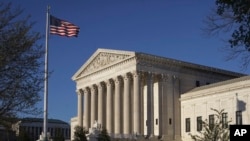The U.S. Supreme Court on Wednesday is again considering the thorny question about the extent to which Democratic and Republican officials should be allowed to shape the boundaries of political districts to try to guarantee themselves as much advantage as they can in elections for the House of Representatives.
The long-standing practice is called gerrymandering. It occurs when state lawmakers piece together sometimes geographically contorted boundaries to create congressional districts that are likely to resort in victories for either Democrats or Republicans, depending on which party oversees the drawing of squiggly boundary lines to include or exclude voters with known political leanings.
Both U.S. political parties engage in the practice, typically once every 10 years after the results of the decennial census leads to the population-based apportioning of the 435 House seats among the 50 states. The next U.S. census is set for 2020.
The Supreme Court has ruled in the past on how state lawmakers can draw congressional boundaries as it relates to the race of voters in their states. But the court has never overturned a state's map because it was designed to help one political party over the other.
The court has two cases at the moment where gerrymandering comes into play, a term coined in the early 19th century in the U.S. when a Massachusetts governor named Elbridge Gerry drew one election that resembled the shape of a mythological salamander, hence the conflated word gerrymander.
In a case related to congressional district boundary lines drawn in the eastern seaboard state of Maryland, the justices are hearing complaints Wednesday from Republicans that Democrats set boundaries with the specific goal of defeating an incumbent Republican congressman in his re-election bid in 2012, which is exactly what happened.
In a similar case, the high court heard arguments several months ago from Democrats in the midwestern state of Wisconsin that Republicans had unfairly reshaped districts there to limit the election chances of Democrats.
The court could issue a joint ruling on the election cases by the end of its current term in late June, possibly forcing changes in election boundaries before all House seats are being contested in November elections across the country.
The Supreme Court could place limits on the extent to which both political parties can shape boundaries to their own advantage. Or it could possibly adopt a more limited approach and continue to mostly leave the once-a-decade practice of shaping of congressional districts up to state lawmakers.
US Supreme Court Considering How Congressional Districts Are Shaped






